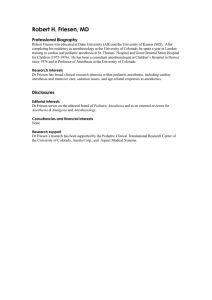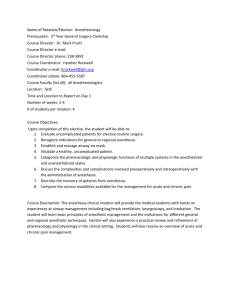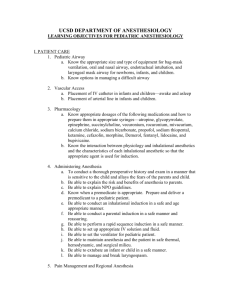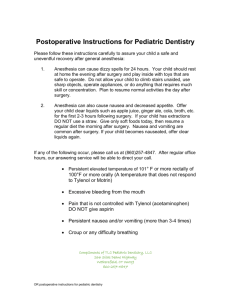CORE - IU Anesthesia
advertisement
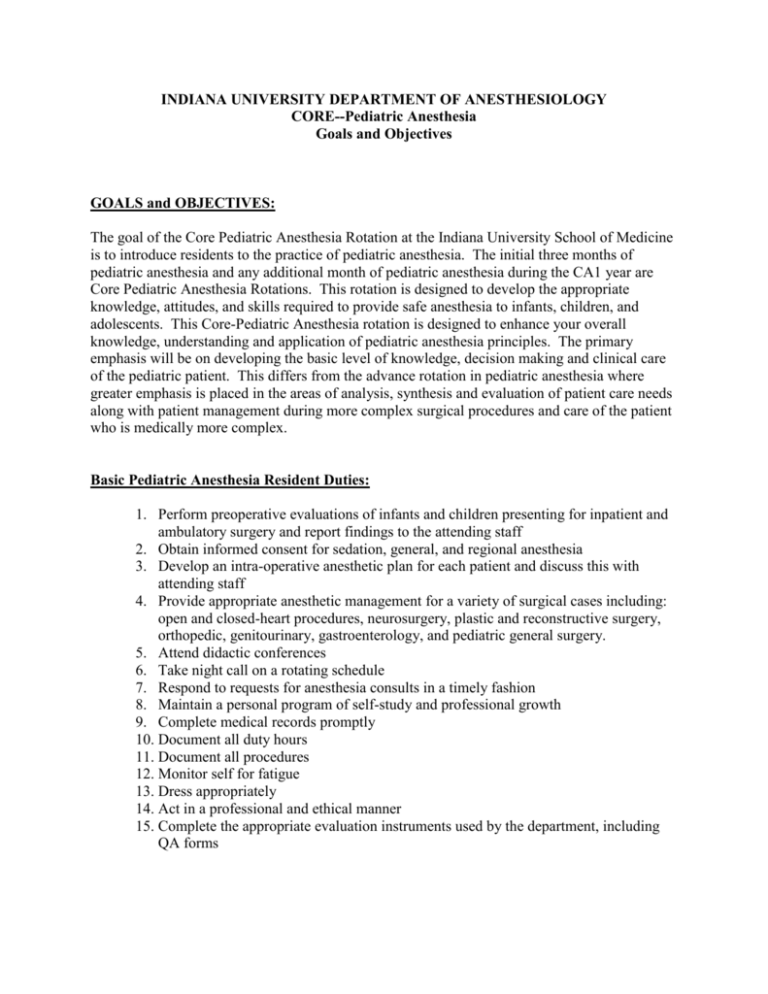
INDIANA UNIVERSITY DEPARTMENT OF ANESTHESIOLOGY CORE--Pediatric Anesthesia Goals and Objectives GOALS and OBJECTIVES: The goal of the Core Pediatric Anesthesia Rotation at the Indiana University School of Medicine is to introduce residents to the practice of pediatric anesthesia. The initial three months of pediatric anesthesia and any additional month of pediatric anesthesia during the CA1 year are Core Pediatric Anesthesia Rotations. This rotation is designed to develop the appropriate knowledge, attitudes, and skills required to provide safe anesthesia to infants, children, and adolescents. This Core-Pediatric Anesthesia rotation is designed to enhance your overall knowledge, understanding and application of pediatric anesthesia principles. The primary emphasis will be on developing the basic level of knowledge, decision making and clinical care of the pediatric patient. This differs from the advance rotation in pediatric anesthesia where greater emphasis is placed in the areas of analysis, synthesis and evaluation of patient care needs along with patient management during more complex surgical procedures and care of the patient who is medically more complex. Basic Pediatric Anesthesia Resident Duties: 1. Perform preoperative evaluations of infants and children presenting for inpatient and ambulatory surgery and report findings to the attending staff 2. Obtain informed consent for sedation, general, and regional anesthesia 3. Develop an intra-operative anesthetic plan for each patient and discuss this with attending staff 4. Provide appropriate anesthetic management for a variety of surgical cases including: open and closed-heart procedures, neurosurgery, plastic and reconstructive surgery, orthopedic, genitourinary, gastroenterology, and pediatric general surgery. 5. Attend didactic conferences 6. Take night call on a rotating schedule 7. Respond to requests for anesthesia consults in a timely fashion 8. Maintain a personal program of self-study and professional growth 9. Complete medical records promptly 10. Document all duty hours 11. Document all procedures 12. Monitor self for fatigue 13. Dress appropriately 14. Act in a professional and ethical manner 15. Complete the appropriate evaluation instruments used by the department, including QA forms Educational Strategy: Core Pediatric Anesthesia Rotations occur in one-month (4 week) block. Every effort is made to provide the initial experience as a two month (8 week) block. During their time on Pediatric Anesthesia residents will be will be supervised by various members of the anesthesia teaching faculty. The Director of Pediatric Anesthesia is Dr. Scott Walker. During rotations on pediatric anesthesia, residents are expected to participate in journal clubs, and morbidity and mortality conferences (QA). Additionally, a packet of materials has been compiled by Dr. Thomas Wolfe and is provided as a means of enhancing their educational experience. During the rotation in ambulatory anesthesia, residents are expected to participate in journal club, and morbidity and mortality conferences (QA). Core Competencies: The six core competencies are used as a template to evaluate residents during all Anesthesia rotations. The terms used to define these competencies are similar to those used for other rotations. The Goals and Objectives that follow have been specifically modified to meet the needs of the specific teaching rotation in which you are to participate. These Goals and Objectives are not intended to be comprehensive but have been developed to help you acquire the core competencies in the area of Clinical Anesthesia. These core rotations should serve as the foundation upon which the subspecialty anesthesia rotations are based. We ask you as the learner to consider how each of the subcategories within these six competencies might relate to cognitive, motor and affective characteristics of your education and your professional behavior. If while reading this document you discover an area that requires revision or improvement please bring these issues to the attention of either the Course Director or the Program Director. We seek changes that will improve your educational experience. EDUCATIONAL OBJECTIVES Medical Knowledge: After completing this rotation, residents will have gained knowledge and practical experience in the anesthetic care of infants and children by: 1. Understanding the basic principles of pediatric anesthesiology 2. Acquiring a solid fund of knowledge regarding the various types of pediatric medical and surgical conditions 3. Appreciating the indications and contraindications and appropriate administration of preoperative pediatric medications 4. Distinguishing the differences between pediatric and adult physiology and the impact of those differences upon the administration of pediatric anesthesia 2 5. Understanding appropriate NPO guidelines for infants and children undergoing surgery 6. Appreciating proper guidelines for pediatric fluid therapy: preoperative, intraoperative and postoperative 7. Understanding the pharmacology of routine and non-routine medications used for the pediatric anesthesia patient 8. Evaluating the child with an upper respiratory tract infection 9. Understanding the pathophysiology and treatment of malignant hyperthermia in the pediatric population 10. Appreciating the basic concepts of pediatric and neonatal resuscitation 11. Ordering appropriate laboratory tests in a conscientious and cost-effective manner. 12. Utilizing material resources within the operating room in a judicious fashion. 13. Managing post-operative pain Patient Care: Using the above medical knowledge the resident is expected to: 1. Demonstrate capability of obtaining an informed consent 2. Practice proper technique in the management of normal airways, providing mechanical ventilation, and temperature regulation 3. Demonstrate proper technique in the placement of venous catheters 4. Exhibit appropriate technique when performing regional anesthesia for inpatient and ambulatory patients 5. Exhibit reliability and dependability in patient care 6. Demonstrate attentive monitoring skills and appropriate responses to alterations in monitoring parameters Interpersonal and Communication Skills: After completing this rotation, residents will have gained experience and competence in: 1. 2. 3. 4. Obtaining an accurate useful patient history appropriate for pediatric anesthesia Completing an informative, legible medical record Communicating skillfully with patients and family members Communicating information about anesthetic procedures with other colleagues including referring physicians, nurses, and workers on ancillary services 5. Effective counseling of patients and families regarding methods of pediatric anesthesia, alternatives, and risks and benefits of treatment options 6. Obtaining informed consent for pediatric anesthesia procedures 7. Answering questions from the patient and or family members regarding pediatric anesthesia issues in a fashion that is knowledgeable and readily understood Professionalism: 3 After completing this rotation, residents will have gained experience and competence in: 1. Acting in a professional manner while providing patient care 2. Demonstrating reliability and dependability 3. Exemplifying compassionate and appropriate patient care 4. Showing respect for patients, parents and families 5. Providing for the emotional needs of patients, parents and families Systems-Based Practice After completing this rotation, residents will have gained experience and competence in: 1. Understanding their role as a patient care advocate 2. Emphasizing safety for the patient as well as operating room personal 3. Working towards developing team building skills Practice Based Learning and Improvement: After completing this rotation, residents will have gained experience and competence in: 1. Self-directed learning 2. Becoming more efficient at locating medical information associated with pediatric anesthesia 3. Reviewing the medical literature related to the field of acute pain and integrating this information with the care of the patient 4. Learning to better utilize information technology to access on-line medical information pertaining to innovative diagnostic and therapeutic modalities in the area of pediatric anesthesia. 5. Transferring knowledge about acute pain to other members of the healthcare team (medical students, ancillary care personal and nursing staff) Trainee Evaluations: The Clinical Competency Committee (CCC) meets every other month to evaluate the progress of the trainees. Specifically addressed are the six basic competencies and the pediatric anesthesia specific competencies outlined above. The instruments used to assess their progress include an evaluation form which utilizes a scaled five point Likert scoring system which assesses each of the six competencies. In house testing is also performed twice yearly to insure that the trainees are acquiring the knowledge associated with the provision of a safe anesthetic. Residents are expected to take the in-training examination administered by the American Society of Anesthesiologists/American Board of Anesthesiology (ASA/ABA). 4 On a more informal (and potentially more important) level, members of the teaching faculty evaluate our trainees daily and provide them real-time feedback concerning their performance in the delivery of anesthesia services. Informal discussions with the pediatric anesthesia residents address any deficiencies in patient care or knowledge base. Additionally, we try to know our trainees personally to better understand and/or address underlying stressors or personal issues that may interfere with learning and performance. Every six months, the American Board of Anesthesiology requires that the Clinical Competency Committee submit a Resident Training and Evaluation Report. In addition to the basic competencies, we submit our evaluation of a trainee’s progress in the following areas: 1. 2. 3. 4. 5. 6. 7. 8. 9. 10. 11. 12. 13. 14. 15. 16. 17. 18. 19. 20. 21. 22. 23. 24. Demonstrates ethical/moral behavior Is reliable, conscientious, responsible and honest Learns from experience; knows limits Reacts to stressful situations appropriately Has no documented abuse of alcohol or illegal use of drugs during this report period Has no cognitive, physical, sensory or motor impairment that precludes individual responsibility for any aspect of anesthetic management Demonstrates respect for the dignity of patients and colleagues Has no restriction, condition, limitation or revocation of license to practice medicine Understands anatomical, physiological, and pathophysiological concepts of organ disease that culminates in the need for solid organ transplant Collects and uses clinical data Recognizes the psychological factors modifying pain experience Communicates/works effectively with patients/colleagues Demonstrates appropriate concern for patients Demonstrates commitment to life long learning Adapts and is flexible Is careful and thorough Generates complete, legible, and accurate medical record Possesses business skills for effective practice management Uses information technology to optimize patient care Is an advocate for quality care Recognizes gaps in knowledge and expertise Demonstrates continuous practice improvement Uses appropriate technical skills in diagnostic and therapeutic procedures Completes study of management of acute pain, cancer pain, and chronic pain Suggested Readings: Suggested reading assignments to expand knowledge and patient care for this rotation include but are not limited to the most recent editions of the following textbooks: 5 A Practice of Anesthesia for Infants and Children - Cote’ et al Pediatric Anesthesia – Gregory Pediatric Anesthesia - Bissonette and Dalens Syndromes – Rapid Recognition and Perioperative Implications – Bissonnette et al. Anesthesia for Genetic, Metabolic, and Dysmorphic Syndromes of Children – Baum and O’Flaherty 6
